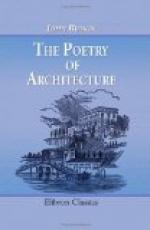the manner and the proportions of nature. The
avenue, therefore, must not be too long. It is
quite a mistake to suppose that there is sublimity
in a monotonous length of line, unless indeed it be
carried to an extent generally impossible, as in the
case of the long walk at Windsor. From three to
four hundred yards is a length which will display the
elevation well, and will not become tiresome from
continued monotony. The kind of tree must, of
course, be regulated by circumstances; but the foliage
must be unequally disposed, so as to let in passages
of light across the path, and cause the motion of
any object across it to change, like an undulating
melody, from darkness to light. It should meet
at the top, so as to cause twilight, but not obscurity;
and the idea of a vaulted roof, without rigidity.
The ground should be green, so that the sunlight may
tell with force wherever it strikes. Now, this
kind of rich and shadowy vista is found in its perfection
only in England: it is an attribute of green
country; it is associated with all our memories of
forest freedom, of our wood-rangers, and yeomen with
the “doublets of the Lincoln green;” with
our pride of ancient archers, whose art was fostered
in such long and breezeless glades; with our thoughts
of the merry chases of our kingly companies, when
the dewy antlers sparkled down the intertwined paths
of the windless woods, at the morning echo of the
hunter’s horn; with all, in fact, that once contributed
to give our land its ancient name of “merry”
England; a name which, in this age of steam and iron,
it will have some difficulty in keeping.
153. This, then, is the first feature we would
direct attention to, as characteristic, in the English
villa: and be it remembered, that we are not
speaking of the immense lines of foliage which guide
the eye to some of our English palaces, for those
are rather the adjuncts of the park than the approach
to the building; but of the more laconic avenue, with
the two crested columns and the iron gate at its entrance,
leading the eye, in the space of a hundred yards or
so, to the gables of its gray mansion. A good
instance of this approach may be found at Petersham,
by following the right side of the Thames for about
half a mile from Richmond Hill; though the house,
which, in this case, is approached by a noble avenue,
is much to be reprehended, as a bad mixture of imitation
of the Italian with corrupt Elizabethan; though it
is somewhat instructive, as showing the ridiculous
effect of statues out of doors in a climate like ours.
154. And now that we have pointed out the kind
of approach most peculiarly English, that approach
will guide us to the only style of villa architecture
which can be called English,—the Elizabethan,
and its varieties,—a style fantastic in
its details, and capable of being subjected to no
rule, but, as we think, well adapted for the scenery
in which it arose. We allude not only to the
pure Elizabethan, but even to the strange mixtures




